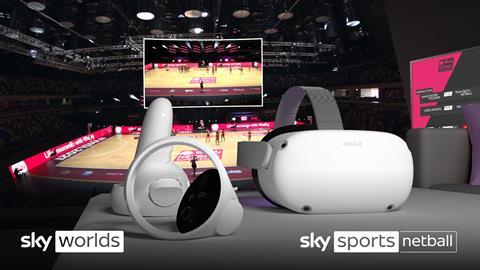Sky Worlds’ Matthew McCartney on why VR and AR smartware has a bright future for viewing live sports content

The future of live sports consumption lies in the broadcaster’s ability to immerse the viewer in the event, transport them to the venue and create a transformative experience.
Broadcasters are in a permanent state of war with each other, fighting to secure rights to the best events.
And with competition becoming fiercer and the marketplace becoming ever more crowded, service differentiation is key to building and securing an audience. Immersive technology holds the key to winning that war.
There are two technical areas that will dictate the next decade as this battle plays out. The first is around the content supply chain, and improvements to cameras, the speed of transcoding, advancement in games engine capability, cloud-based rendering and, of course, 5G delivery.
The second is in the consumer devices themselves – How will virtual reality headsets evolve? When will augmented reality glasses become widely available? How will these devices interact with traditional devices? How cheap and comfortable will they be? – and, of course, 5G connectivity.
The technology behind content supply chains is ever changing and we are now in an age where spherical live streams and real-time 3D performance capture is possible.
Companies like Unity and Unreal make it possible to deliver experiences across a range of platforms and broadcasters are beginning to take advantage of this, such as the Sky Scope AR presentation at the Open in 2019.
Sky has also created Sky Worlds, a virtual reality (VR) viewing platform that allows people to get back into stadiums, direct their own views, watch with friends and interact with stats and data.
The in-market offering today will only grow as the technology evolves, with richer streaming options and 3D performance delivery adding to the rich data on offer. It will eventually evolve from VR into AR, and possibly create a shared experience with TVs, but is really focusing on 5G-enabled consumption.
At the consumer end, companies like Oculus, Nreal, Apple and others are making great strides in building lower costs, higher performance devices. Currently the VR devices are leading the way, with the Oculus Quest being the front runner.
But VR is not the end product for broadcast consumption, merely the first step in a journey that will lead to a complete 5G-enabled AR world, one where people can travel the length and breadth of the country consuming rich, immersive content as they go.
For this next generation of devices to be successful they need to be affordable, easy to use and, critically, desirable. The major tech companies are already working towards this end and with the announcement that Oculus is partnering with Ray Ban to create just such a device in the near future, it is highly probably that within the next few years fashionable, affordable, 5G enabled smartware will be commonplace.
While VR is playing an important role in the evolution of immersive viewing today, the underlying technology that delivers the content and the fast approaching AR smartware will shape the future. Through the work Sky is undertaking today we will be well placed to take advantage of all the opportunities this new format will unlock.

Matthew McCartney is head of immersive technology at Sky





No comments yet